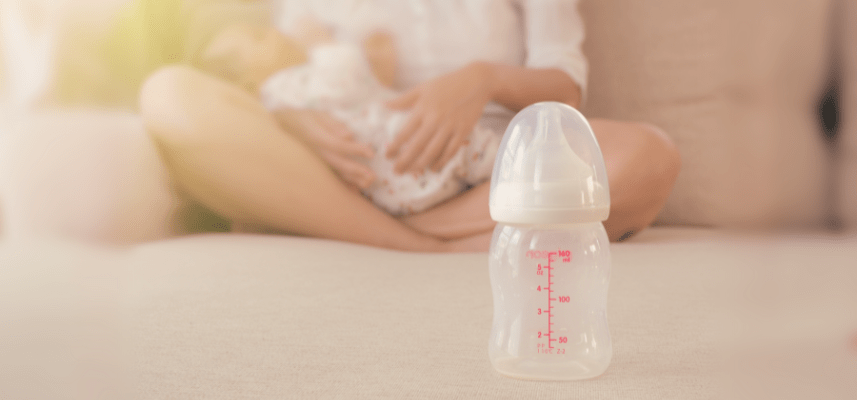Adding a bottle to your breastfeeding and pumping arsenal is often necessary for working moms returning to the office or mamas who spend time away from home and their little one. Bottle feeding enables caretakers other than mom the ability to feed baby, giving partners an opportunity to experience feeding and giving mom more flexibility.
Understanding when and how to do this is essential for a smooth transition for both mom and baby! The world of baby bottles is vast and varied, and with so many choices it is normal to feel overwhelmed at first. But with the right information and preparation, parents can transform feeding time into an opportunity for bonding rather than stress. Here’s everything you need to know to get started:
When To Introduce a Bottle
Lactation consultants often recommend waiting until direct breastfeeding is well-established, usually four to six weeks after birth, before introducing a bottle to ensure that breastfeeding is well-established. Direct breastfeeding during this period helps stabilize mother's milk supply and gives your baby time to develop a strong latch, minimizing the risk of nipple confusion. If the breastfeeding routine is disrupted too early, it can also impact milk production negatively, so it’s best to wait out this period before introducing a bottle into the mix.
It's also important to consider your individual situation when planning your timeline and goals. If you’re planning to return to work or you anticipate being separated from your baby for an extended period, you may want to start bottle feeding several weeks in advance. This lead time allows new mamas and their babies to adjust to the new feeding method and patterns.
Signs Baby Is Ready for Bottle
Some babies take to a bottle right away, and others need time to adjust. Each baby is unique, and their feeding flexibility will vary.
Signs that your baby may be open to bottle feeding include:
- Showing an interest in the bottle
- Opening their mouth when the bottle's nipple touches their lips
- The ability to suckle effectively
If your baby resists or becomes upset, you might want to wait a few more days before trying again.
Breast Pumping for Bottle Feeding
If you are pumping breast milk, try to pump whenever your baby is feeding from a bottle to maintain a consistent milk supply. This helps to ensure that your milk production aligns with your baby's demand.
Many of the health benefits of direct breastfeeding are still available to babies fed pumped milk, and these benefits are more pronounced if you are able to track the time of day your milk is pumped and ensure that timing corresponds with feeding times. For instance, milk pumped in the morning should be given to baby in the morning, and milk pumped in the evening should be given to baby in the evening. Why? Your milk’s hormonal makeup varies throughout the day to match your baby’s needs, so paying attention to when milk is pumped and provided will help ensure that the specific makeup of your milk matches your baby’s needs.
Our team can help you find the right pump for your needs and goals and help see if you qualify for a free or discounted breast pump through your insurance! Fill out our Qualify Through Insurance form, and let us take care of the rest. An Aeroflow Breastpump Specialist will work with your insurance provider to verify your coverage and will contact you within three to five business days to discuss your breast pump options.
For guidance on combining and storing refrigerated or frozen milk, check out this blog.
Tips To Introduce Baby to Bottle
Breastfed babies may be hesitant to accept a bottle due to changes in flow rate, differences in nipple feel, or a million other reasons. As difficult as it may be, try to approach this process with patience. It may take multiple attempts or several weeks!
Try these tips when starting out to help you reach feeding success:
- Don’t wait until your baby is super hungry. While this may sound backward, waiting to try bottle feeding for the first time when your baby is already hungry may not lead to the best results. By this point, your baby may be fussy or irritated and not as willing to try a new feeding method. We recommend trying the first bottle shortly after your baby’s evening feeding (no more than one ounce of breast milk).
- Try to be away (out of the house, if possible). Let a family member or loved one feed the first bottle! Sometimes, simply having mom out of sight can help the baby accept the bottle more readily, as they associate their mother with breastfeeding.
- Try a slow-flow nipple. These nipples can be more similar to the flow of milk from a breast than regular-flow bottles, and they are a great tool when helping your baby get used to feeding from a bottle. Additionally, using too fast a flow can lead to overfeeding and may cause the baby to prefer the bottle over the breast because it requires less effort.
- Help set a feeding pace. Paced feeding is a bottle-feeding strategy that helps slow the feeding process to make it more similar to breastfeeding. Paced feeding strategies can include holding baby semi-upright while they feed, not topping the bottle too much, which can increase flow due to gravity rather than sucking, and taking lots of feeding breaks. Paced feeding helps teach your baby how to control the amount they consume, reducing the risk of overfeeding and aiding in digestion.
If your baby has a rough time adjusting to the bottle feedings, you might want to try warming the breast milk to body temperature before feeding (a bottle warmer can be a huge help!) or try bottle feeding when the baby is sleepy or just waking up.
Other feeding strategies include presenting the bottle in a calm environment and using movement to soothe while feeding.
Getting Additional Help
Lactation consultants are a great resource when introducing your baby to a bottle. Our board-certified lactation consultants at Aeroflow offer one-on-one support and classes to address various feeding issues.
Choosing the Right Nipple Size
When it comes to choosing bottle nipple sizes, it might take a few tries before finding the right fit for your baby.
The ideal nipple doesn’t cause any spillage around the lips and helps your little one feed at their own pace, reducing the risk of discomfort or indigestion. Pay attention to the milk flow rate of the nipple—finishing a bottle in under five minutes often suggests a fast flow, while longer than 30-45 minutes may indicate that the flow is too sluggish.
Remember that every baby has a different feeding pace, and the nipple size they need may not directly correlate to their age. If you have any concerns about their progress, reach out to a lactation consultant for nipple recommendations and support.
The first nipple you try may not be the one your little one prefers! Some trial and error is totally normal and to be expected during this process.
Bottle Care and Cleaning
Sanitizing your bottles once daily and washing your bottles after each feed helps reduce the spread of germs and the risk of infections. Thoroughly clean each part of the bottle with soapy water, using a bottle brush for hard-to-reach areas, and then sanitize the components using a steam sterilizer, boiling water, or microwave sterilizer bags, following the manufacturer's instructions.
Some bottles may be dishwasher safe, so be sure to check yours before cleaning to make sure you’re using the proper care. These measures prevent contamination and protect your baby during bottle-feeding sessions!
Remember that every child is unique, so while some babies may take to the bottle quite quickly, others may need a bit more time or encouragement. This doesn’t mean there is anything wrong with you or your baby! The key is to always approach bottle feeding with positivity and care to make sure your baby feels secure throughout the process.
Information provided in blogs should not be used as a substitute for medical care or consultation.









